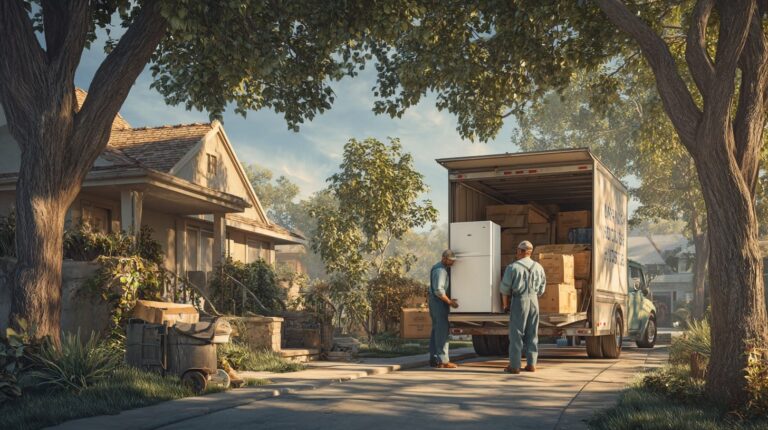That moment is familiar to many of us in rural places. We see the mess, we know the cost of hiring someone, and we wrestle with whether our own arms and patience will suffice. Maybe you’ve stood before a barn full of castoffs and thought the same: Do I have what it takes?
Now, keeping that moment in mind, let’s talk about the gear and tools that make a self-hauling project not just possible—but safe, efficient, even a little dignified. Because the difference between a bruised body and a job well done often lies in the right tool at the right time.
Why Choose DIY Junk Removal?
(Mindset & Motivation)
There’s something quietly powerful in saying, “I’ll do this myself.” In remote regions, services are fewer, distances are longer, and the cost of a truck hauling in is higher. Doing your own junk removal can save money, give control over sorting (what to keep, what to donate), and yield a deep satisfaction in finishing the work with your own hands.
Yet there’s humility in it too. You must recognize your limits — when a load is heavier than safe, when specialized machinery or experience is needed. Trusting yourself means also knowing when to call in help.
Planning & Prep: Tools Before the Haul
Before you ever lift a thing, set yourself up to succeed.
Assessment & Strategy
Walk the site. Photograph problem areas. Measure doorways, trailer openings, clearances. Mark items into categories: haul, donate/sell, breakdown, dispose. A clear map in your mind (or sketch on paper) saves wasted trips and frustrating dead ends.
Protection & Safety Gear
These are the silent heroes of every lasting haul:
- Heavy work gloves (leather or cut-resistant)
- Safety glasses or goggles
- Dust mask or respirator (especially for moldy, dusty, or old materials)
- Steel-toe boots or reinforced footwear
- Long sleeves, durable pants, knee pads
- First aid kit, flashlight, utility knife
I once skipped gloves when moving metal scraps—and ended up with a shallow cut deep enough to slow me for days. Small tools of care matter.
Sorting Tools
Set up bins, tubs, tarps, labeling supplies for keep, donate, trash. Use heavy-duty contractor bags. The act of organizing as you go saves hours later.
Big Movers: Lifting & Dismantling Tools
When “junk” is heavy, awkward, or stuck, brute muscles alone won’t cut it.
- Hand truck / appliance dolly: These transform a bulky fridge, dresser, or couch into something manageable. Many guides suggest renting heavy dollies if you won’t use them often.
- Furniture sliders / skid plates: Useful for sliding heavy objects across floors without scratching or fighting friction.
- Straps, ratchet ties, bungee cords, ropes: To secure items; many removal guides stress these as essential.
- Pry bars, crowbars, nail pullers: Key for dismantling or prying things apart. Crowbars and pry tools are listed among essential removal gear in industry articles.
- Sledgehammer, mallet, reciprocating saw (Sawzall): Break down frames, wood, metal into manageable pieces.
- Trailer ramps / loading ramps: To roll or slide heavy items into a truck or trailer.
I once tried to drag a broken sofa up my driveway by sheer will (and no dolly). By the time I reached halfway, sweat soaked through, I knew: leverage, not brute force, matters more than hubris.
Transportation & Containment Tools
Your truck or trailer is your vessel, but without the right containment gear, it’s only half useful.
- Truck, trailer, or pickup bed – make sure the vehicle is reliable and big enough.
- Tarp, netting, cover – to keep debris from flying or spilling.
- Side walls / stake walls on trailer – help prevent shifting loads
- Ratchet straps & load binders – to anchor the load securely. Many sources emphasize that poor containment isn’t just messy—it’s dangerous.
I still remember one trip where a stray board popped off the trailer frame on a winding dirt road. The jolt made me stop mid-haul, heart pounding. Containment isn’t optional—it’s respect for your work and your surroundings.
Cleanup & Support Tools
After the heavy lifting, there’s always debris, dust, and fragments.
- Brooms, shovels, rakes – for gathering loose debris
- Shop vacuum, dustpan – for finer cleanup
- WD-40, penetrating oil – to loosen stubborn bolts or rusted hinges
- Basic hand tool set (wrenches, screwdrivers, pliers) – for disassembly
- Wheelbarrow or garden cart – especially for yard waste
- Optional: grabber reachers, bolt cutters, angle grinder (for more extreme jobs)
Often what separates a job done and a job well done is the cleanup.
Tool Maintenance, Safety & Workflow Practices
- Keep blades sharp, tools clean, rust free
- Inspect straps, dolly wheels, rope wear
- Lift safely—bend knees, keep your back neutral, don’t twist under load
- Break the work into manageable phases rather than trying to gut everything in one day
- Hydrate, rest, call in help when the load exceeds your safe capacity
Sometimes pausing is not weakness, but wisdom. Pushing through fatigue is how accidents happen.
When to DIY vs. When to Hire Help
It’s tempting to go “all in” on DIY, but there are real tipping points:
- Calculate dump fees, fuel, your time, and tool wear
- Factor in potential mistakes or multiple trips
- Compare with estimates from local junk removal services
- If a piece is too dangerous, too heavy, or too complex, call help
In some months I’ve been proud I did it all myself. In others, I’ve quietly called in professionals—and that taught me more about timing and discernment than any tool ever could.
Inventory Checklist
| Category | Must-Have Tools | Nice-to-Have / Optional |
|---|---|---|
| Safety & Prep | Gloves, safety glasses, respirator, boots, first aid kit | Knee pads, headlamp |
| Lift & Move | Dolly, sliders, straps | Shoulder dolly, extra ropes |
| Demolition / Breakdown | Crowbar, reciprocating saw, hammer, pry bars | Angle grinder, bolt cutters |
| Transport & Containment | Trailer/truck, tarp, ratchet straps | Stake walls, nets, ramps |
| Cleanup & Support | Shovel, broom, hand tool set, vacuum | Grabber tool, WD-40, extra shovel, wheelbarrow |
Stories from the Field
- Two Tons of Scrap Metal on the Farm:
“I once cleared out two tons of scrap across my acreage. One bent pry bar threatened to slow me—but replacing it mid-day reminded me how every tool, even the cheap ones, matters.” - Neighbor’s Barn Cleanup:
“My neighbor cleared his old barn with only a dolly, a tarp, and a chainsaw. He paced himself across weekends, and I watched him turn chaos into open space with patience and six good tools.” - What Broke & What Endured:
“Over years, I’ve broken straps, lost wrenches, overstrained pulleys. The tools that survived were the ones I maintained, respected, and didn’t abuse.”
Conclusion: More Than Tools
Tools are windows to intention. We don’t collect them to show off, but to serve purpose. In the quiet moments—when your back trembles, when the sun dips, when hauling seems endless—you discover something deeper: trust in disciplined effort, wisdom in timing, humility in asking for help, and sometimes a whisper that you’re not alone in the work.
Maybe that’s the point. The gear helps, but it doesn’t do the heart’s labor—the choosing, the starting, the perseverance.
So take this list, walk your property tomorrow morning, and say the small brave thing: I will begin. And if the load proves too much, know this: a call for pickup isn’t failure, but stewardship of your own safety.
Let me help you close the loop. When hauling surpasses your hands, book a pickup today. Let us shoulder the heavy lift, while you reclaim your space and peace of mind.





